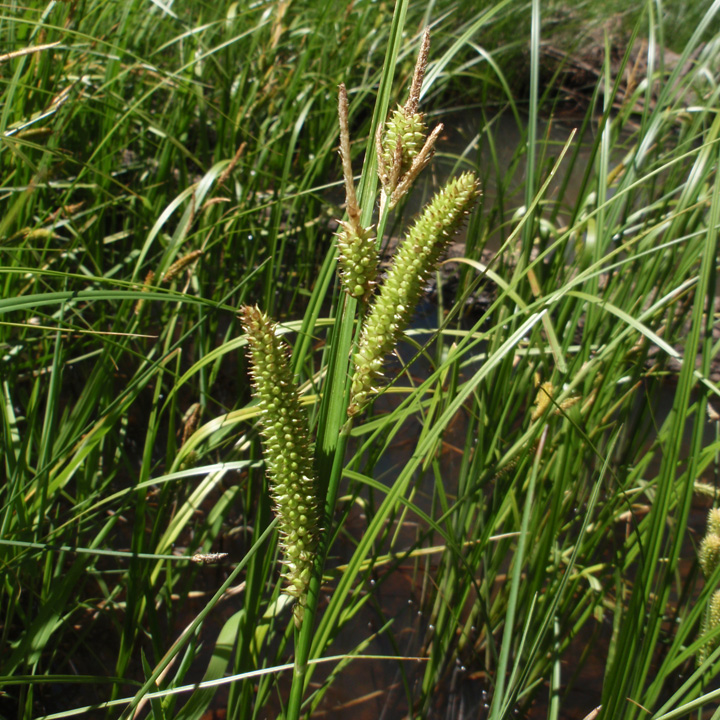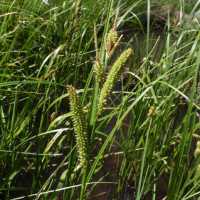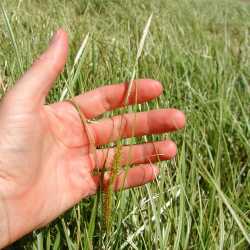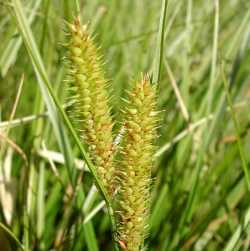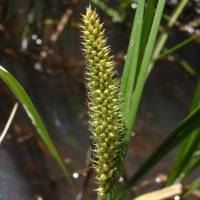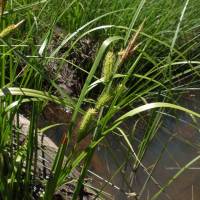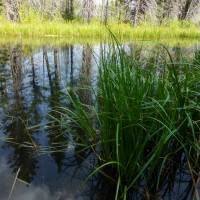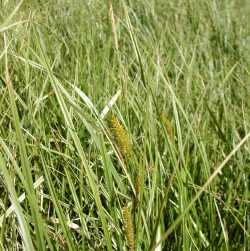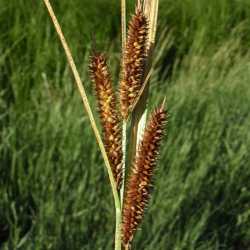Plants colonial; rhizomes long. Culms trigonous in cross section, 25-100 cm, smooth or somewhat scabrous-angled distally. Leaves: basal sheaths brown or lightly tinged with pinkish red, spongy-thickened; ligules as long as wide; blades pale to mid green, flat to broadly V-shaped, widest leaves 4.5-12(-15) mm wide, glabrous. Inflorescences 10-40(-50) cm; proximal bract 12-55(-75) cm, exceeding but not more than 2.5 times longer than inflorescence; proximal 2-5 spikes pistillate, erect or the proximal ascending, ca. 20-150-flowered, cylindric; terminal 2-5 spikes staminate, well elevated beyond summit of separate pistillate spikes. Pistillate scales lanceolate ovate, 2.6-5.5(-7.6) × 0.8-1.7(-2.1) mm, mostly shorter than perigynia, margins entire, apex acute to acuminate, awnless (rarely acuminate-awned). Perigynia spreading, often green or straw colored, 9-15-veined, veins running into beak, ovate, (3.2-)4-8.6 × 1.7-3 mm, apex contracted; beak (1-)1.2-2.7 mm, bidentulate, smooth, teeth straight, 0.2-1.3 mm. Stigmas 3. Achenes brown, symmetric, not indented, trigonous, smooth.
Fruiting Jun-Aug. Open swamps, wet thickets, marshes, sedge meadows, bogs, fens, stream, pond, and lakeshores; 0-3500 m; Alta., B.C., Man., N.B., Nfld. and Labr., N.W.T., N.S., Nunavut, Ont., P.E.I., Que., Sask., Yukon; Alaska, Ariz., Calif., Colo., Conn., Idaho, Ill., Ind., Maine, Md., Mass., Mich., Minn., Mont., Nev., N.H., N.Mex., N.Y., N.C., Ohio, Oreg., Pa., S.Dak., Tenn., Utah, Vt., Va., Wash., W.Va., Wis., Wyo., Mexico; Eurasia.
Carex utriculata is abundant and variable and is often a dominant of wetlands in subarctic, boreal, and north-temperate wetlands. American authors usually treat the taxon as part of the variation of Carex rostrata, but it is a very different plant with a quite different leaf shape in cross section and very different leaf anatomy. Plants from the western and northern portions of the range often have perigynia strongly tinged with purple, though that coloration can also occur rarely elsewhere.
Rarely, Carex utriculata forms hybrids with C. exsiccata, C. hystericina, C. lacustris, C. pellita, C. rostrata, C. rotundata, C. saxatilis, and C. vesicaria. The hybrids are sterile and intemediate in morphology.
Frequent in northern Indiana in marshes, swamps, low woods, wet roadside ditches, and swales and on borders of ponds and lakes, often in shallow water. It is a very widespread species but generally is not plentiful in any one locality.
Colonial by long, stout, deep-seated creeping rhizomes, sometimes forming a dense sod; stems 5-12 dm, bluntly trigonous, smoother than in no. 220 [Carex bullata Willd.]; lvs septate-nodulose (especially the sheaths), flat, yellow-green, smooth above, the larger ones 5-12 mm wide; lvs subtending the pistillate spikes nearly or quite sheathless, but at least the lowest one with an elongate blade 1-2 times as long as the infl; spikes several, remote, forming an elongate infl, ±erect, the upper ones staminate and 2-7 cm, the lower pistillate, 2-10 cm, ca 1(-1.5) cm thick at maturity, only the lowest one sometimes evidently pedunculate; pistillate scales narrower and usually shorter than the perigynia, acutish to more often acuminate or short-awned; perigynia densely crowded, mostly in 8+ vertical rows, widely spreading at maturity, glabrous, shining, ±strongly 8-16-nerved, 4-7 mm, the inflated, broadly ellipsoid to ovoid or subglobose body rather abruptly contracted to an evident smooth beak 1-2 mm with short (0.2-0.8 mm) teeth; achene yellowish, trigonous, 1.3-2 mm, loose in the lower half of the perigynium, its persistent, bony style becoming strongly flexuous or contorted with maturity; 2n=82. Wet soil or shallow water; boreal Amer., s. to Del., Ind., Nebr., N.M., and Calif. (C. rostrata, misapplied)
Gleason, Henry A. & Cronquist, Arthur J. 1991. Manual of vascular plants of northeastern United States and adjacent Canada. lxxv + 910 pp.
©The New York Botanical Garden. All rights reserved. Used by permission.


